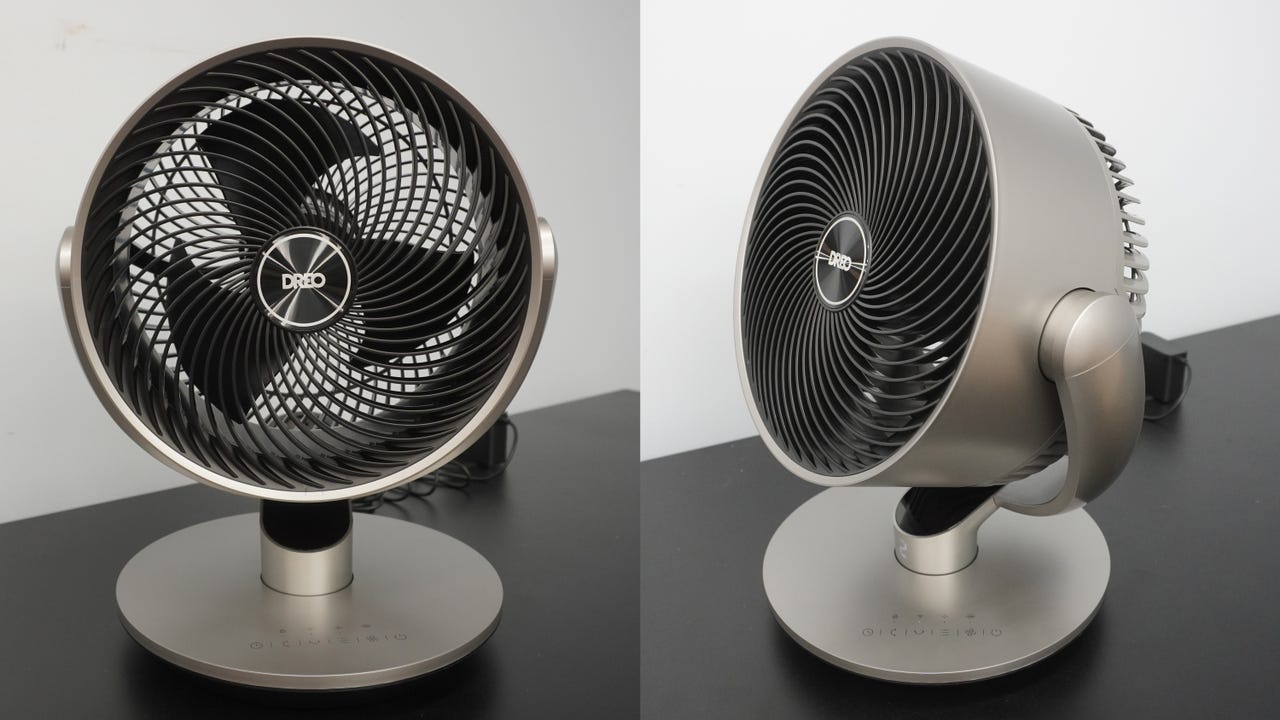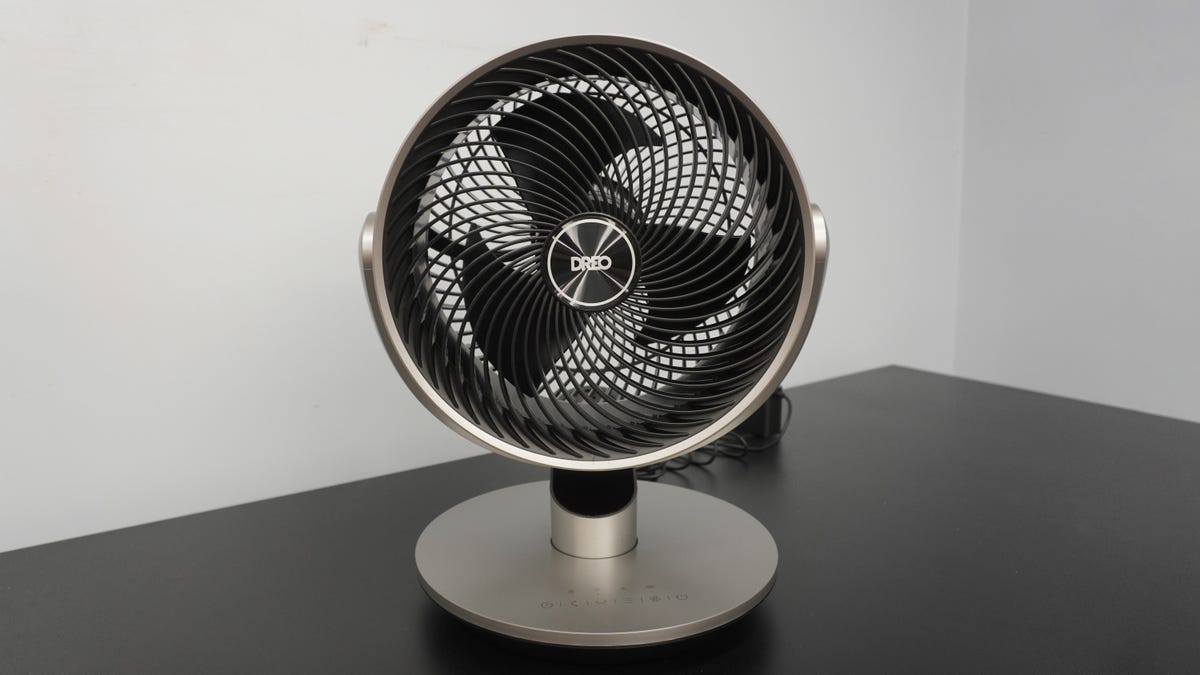How I’m using this $100 smart fan to beat the summer heat

The Dreo fan sports a modern and pleasing design. David Gewirtz/ZDNET
As a fan, the Dreo CF714S is an impressive piece of kit. As a smart device, it misses some relatively obvious opportunities. All told, if you wanted to spend a hundred bucks on a fan and your big concern was moving a ton of air, this is a worthwhile buy.
Editor’s note: We reviewed this fan as the “Falcon S” but the company subsequently changed its name to CF714S. Go figure.
If you want something that takes app control and smart features and gives you fine-grained control, you may want to consider the alternatives.
ZDNET RECOMMENDS
Dreo CF714S
The CF714S is a smart app, Alexa, and Google Home-controlled fan capable of moving a lot of air. When operated at lower speeds, it’s also very quiet and looks good in an office or home.
Dreo’s marketing materials say that the Falcon S pushes 1082 CFM airflow that goes as far as 110 ft away. My house is not nearly that big, so I couldn’t verify their exact claim, but this beast moves a whole lot of air. Turned up to its maximum, it’s almost too intense to stand in front of, and it easily got air moving 20 feet away at the far end of my workshop (the longest room in our house).
In terms of sound, I did a rudimentary sound check standing right in front of the unit and using my Apple Watch’s Noise app. Ambient room noise was at 48db and at its lowest settings, the fan didn’t increase the ambient room noise at all. At low speeds, this is a very quiet fan.
Also: Best window A/C units: GE, Friedrich, and more
But if you crank it up, the sound increases to 84db, which the Apple Watch says is potentially dangerous for long-term exposure. There’s no way you’re going to stand right in front of the fan when it’s fully cranked to the max. From 10-15 feet away, the sound level is perfectly reasonable.
One feature I found really nice was the ability to point the fan straight up. This allowed the air to circulate, but not directly blow on anyone. In combination with the app’s ability to circulate air at differing speeds, the fan can create a very nice ambient breeze. I think that might be my favorite feature.
We’ll come back to the app in a minute, but first let’s finish up on the physical features of the fan. The fan comes with a fairly rudimentary remote control that lets you increase or decrease fan speed, set horizontal or vertical oscillation, and change the fan mode.
Fan mode and speed are shown via a display located on the shank of the fan. There’s also an array of touch buttons towards the front of the fan that you can use should you not have the remote control handy.
App control
The app offers a lot of capabilities. You can control the vertical and horizontal oscillation, set a sleep timer, and even set the fan to come on or shut off based on ambient room temperature.
Finally, you can control the fan with Alexa and Google Home. It responds to voice commands for speed, on and off, oscillation on and off, and specific modes like Normal, Sleep (which reduces fan intensity over time), Natural (which varies speed), and Auto (which sets the fan to run based on temperature).
Missed opportunities
This fan has so many capabilities that I found its missed opportunities surprising. You can’t use Alexa or Google Home to control vertical and horizontal oscillation independently. You also can’t ask Alexa or Google Home for the temperature measured by the fan, even though it’s constantly measuring ambient room temperature.
Also: This thermal camera is so sensitive it can see you breathe
But by far, the biggest missed opportunity is app and voice control presets. The app can move the fan left and right and up and down. It can also set fan speed. So why can’t it respond to a preset that sets the fan’s vertical and horizontal position and speed? One preset might point directly at you at medium speed. Another preset might point the fan upward, turn on the Natural mode for an ambient breeze and set the speed at 2.
I’m disappointed because the company obviously took a lot of time with the app, and put the hooks for all of that control both into the app and the fan. But all the app does is serve as a backup remote control, with the addition of the ability to run the fan at different speeds based on room temperature.
The fan does accept firmware updates, and I hope that Dreo updates the fan, the smart assistant apps, and the main app to allow for presets, temperature reporting, and independent oscillation modes.
Should you buy this thing?
As a fan, it’s really pretty great. Is it worth a hundred bucks as a fairly limited smart fan? That’s something you’ll have to decide. I was bummed to find out I couldn’t use Alexa for fine-tuned control when all the capabilities were built into the fan, but the CF714S is fairly price comparable to other fans with similar feature sets. At the time of writing, it’s also 10% off with the Amazon clip-on coupon.
Also: This Alexa-controlled fan is the smart home luxury I didn’t know I needed
Speaking personally, if Dreo were to update the device to support presets, I’d say it’s absolutely worth $100. Even without that, I wouldn’t hesitate to buy it if I needed to move a lot of air across a fairly long distance.
You can follow my day-to-day project updates on social media. Be sure to follow me on Twitter at @DavidGewirtz, on Facebook at Facebook.com/DavidGewirtz, on Instagram at Instagram.com/DavidGewirtz, and on YouTube at YouTube.com/DavidGewirtzTV.




